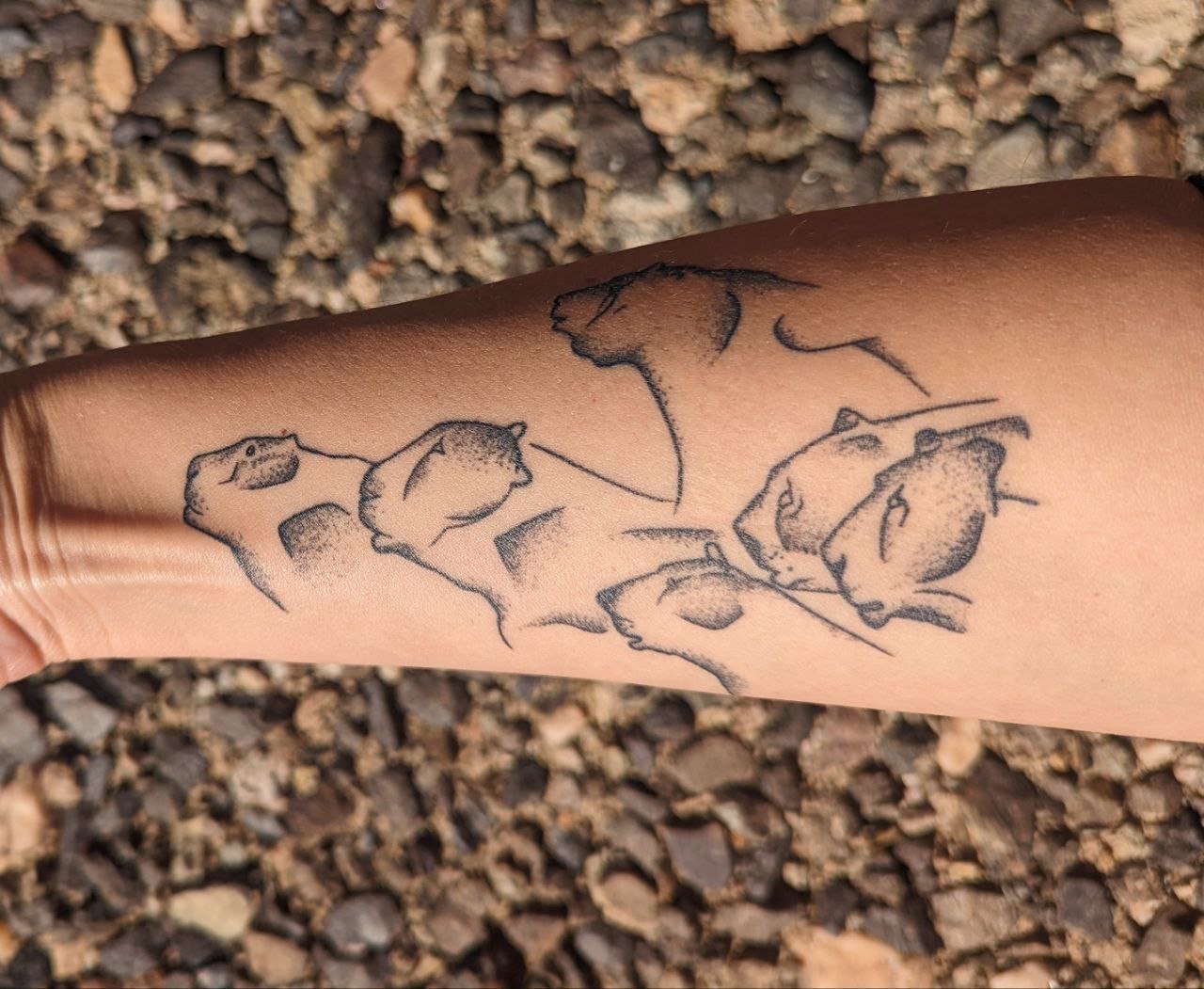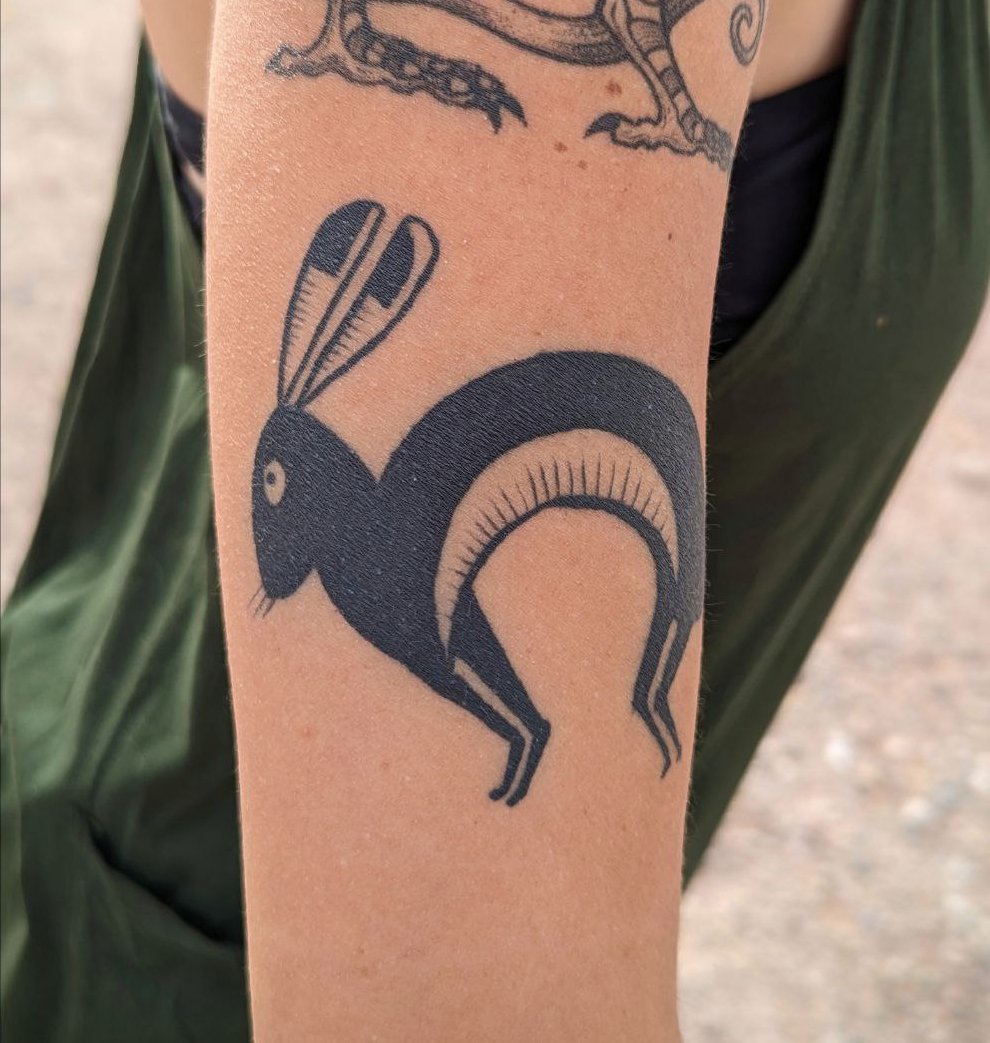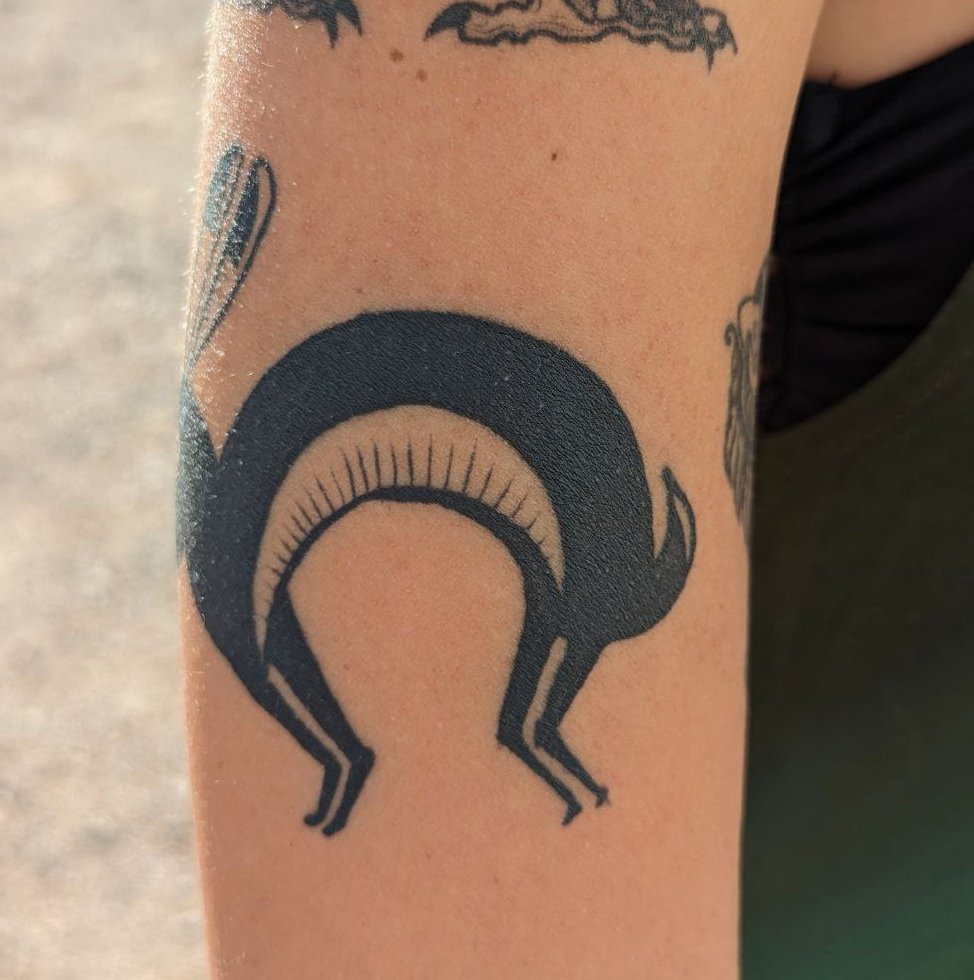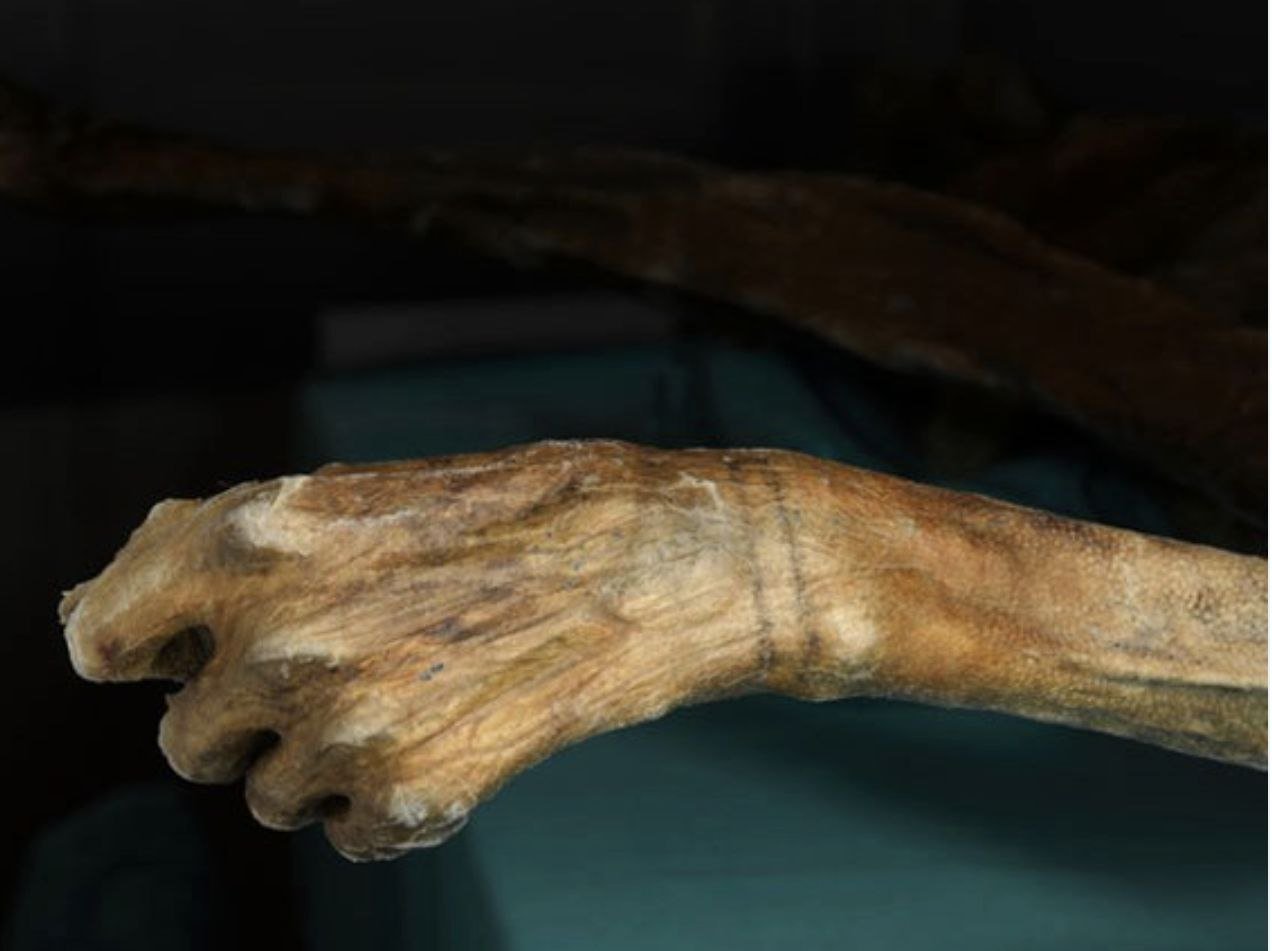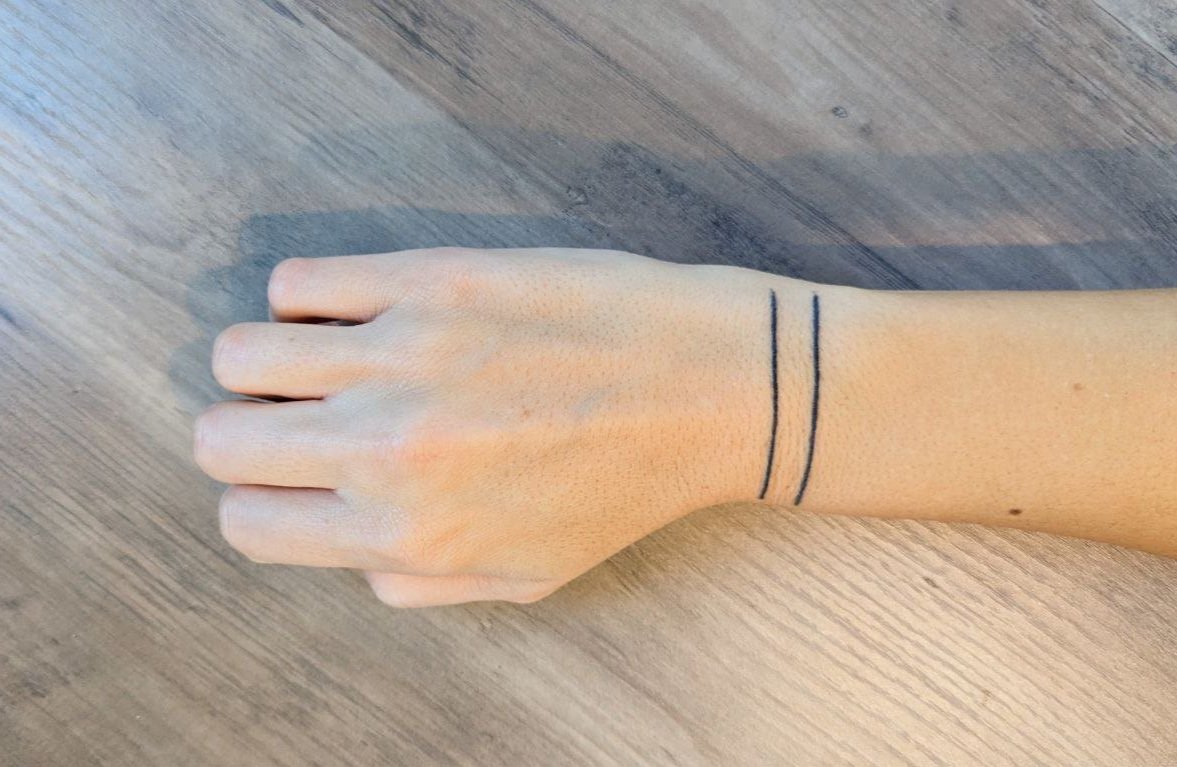Tattoos
From the moment I decided I wanted to get tattooed, I had a clear vision in mind- a collection of ancient art. In all of its many forms, art from ancient history, especially prehistory, is something that has always spoken to me. There is nothing more human than wanting to create something outside yourself, hoping to leave a small piece of soul in tangible form, whether it reflects supernatural belief, an expression of self, or the legacy of a people. To me, nothing cuts closer to connection with our past than examining the art we have left scattered across the world over the millennia. Gathering the pieces that speak to me the most on my skin is my own way of connecting and honoring the human artistic spirit.
Pazyryk Deer, 5th-3rd century BCE
Tattooing itself is a form of ancient art, much older then most people realize. My first tattoo pays homage not just to the culture to whom it belongs, but also the incredible, often mystical power ink on our skin has held for thousands of years.
The Pazyryk tribe was a sub-group of the larger nomadic Scythian culture that lived on the Eurasian steppes from the 6th century BCE- 2th century BCE. Scythians were contemporaries of the ancient Greeks and written accounts of their existence mainly come from the Greek historian Herodotus. Having no written legacy of their own, Scythian art is one of the few ways to try to understand this culture directly.
The most famous piece of Scythian art was discovered in 1993, when archeologist Natalia Polosmak unearthed the tomb of a mummy in Altai, Russia. The mummy, a woman interred with many artifacts and six sacrificed horses, was a person of great importance, possibly a shaman or a story-teller. Her tomb was preserved in the tundra ice so well that her burial meal had laid intact for over 24 centuries, including a small bowl of yogurt.
The tattoo on her left shoulder is iconic for its beautiful design. It is most commonly referred to as some sort of a ungulate chimera, with a raptor’s beak and swooping, elaborate antlers. Based on other deer imagery in rock carving and tombs, it is believed that the deer represents a supernatural, shamanistic carrier or messenger to the afterlife.
Different artifacts from this time give us greater insight into the design of this creature. Leather and felt headdresses for Scythian horses transformed them into the mystical deer. Perhaps most fascinating is other artifacts, made of gold and other metals, that clearly display the swoops of the antlers as bird heads.
You can read a first-hand account by the archeologist who discovered the ‘Ice Maiden’.
Pazyryk Ram, 5th-3rd century BCE
My second tattoo comes again from the Pazyryk tribe. Five mummies were excavated around 1947, all tattooed in various fashions. A large man determined to be a chieftain had his entire arm covered in fantastic beasts, including a ram that stood out to me because of its beautiful curving horns. The ram is most likely an Argali, a mountain sheep that is native to East Asia, the Himalayas, and the Alati Mountains.
Chauvet Cave Lions, 33k Years Before Present
The Chauvet-Pont-d'Arc Cave in southeast France is home to some of the best preserved figurative cave paintings in the world. Discovered in 1994, the walls are covered in hundreds of charcoal animals paintings, depicting over 13 different species from the Upper Paleolithic period. Many panels have processions of animals, such as horses, rhinos, and, my favorite, the cave lions. According to prehistorians, lions were symbols of power accorded a higher status than other mammals. These depictions in particular have a strange quality, with some anthropomorphic and distorted features among the lions. One theory is that they actually represent shamanistic shapeshifters. It’s possible that prehistoric shamans invoked the spirits of these animals through paintings, hoping to harness their power for rituals and rites of passage. The most elaborate paintings are deep inside the dark recesses of the cave system. Lit only by torchlight as they painted, the artists could have possibly been starved of oxygen and in a state of hypoxia, which can lead to hallucinations and out-of-body experiences, furthering creating a sense of connection to the otherworld.
The mix of high and low quality drawings may also suggest different artists, or apprentices studying a master. Another theory is that the staggered placement of the lions actually depicts a proto-animation of one or several lions surging forward in a hunt.
The massive cave was a hibernating spot for cave bears, which among other dangers present in caves, shows how important this art must have to create, despite the risks. The art of Chauvet Cave transcends above any of its contemporaries and shows a shift in how prehistoric people interacted with their world and the creatures in it, as well as their creative abilities. These paintings have endured the longest out of all my ancient art collection, and yet their humanity still speaks through the ages.
You can view all the paintings of Chauvet Cave here.
Mesopotamian/Persian Griffin, 860 BCE/510 BCE
This tattoo is a bit different from my others in that I decided to make several pieces of similar art into a composite. I had discovered Melanie Steinway, a Colorado tattoo artist, and wanted her to use her incredible style to bring to life the Middle Eastern griffins I had long admired in museums. Half-lion, half-eagles have been an artistic mainstay of cuneiform culture from at least the third millennium BCE.
The first, more whimsical set of griffins comes from a frieze excavated from the palace of King Darius I the Great in the ancient city of Susa, Persia. Made up of bricks coated in colorful glazes, thousands of these wall elements featuring animals and mythological creatures decorated the architecture.
The second, older griffin depicts a specific deity, the monster Anzu. In this bas-relief, pulled out of a buried temple in the Assyrian city of Nimrud, Anuz fights the warrior god Ninurta. Cuneiform writing was contemporary to when this relief was created and there are legends that accompany this piece. In The Epic of Anzu, Anzu steal the gods’ Tablets of Destinies and uses them to turn back time and defeat the laws of nature. Ninurta is able to trick Anzu and kills him, which is a shame because Anzu seems pretty cool.
Apparently, this bas-relief also shows that Anzu has a prominent snake-headed penis. Thankfully, it is harder to notice and didn’t make it into the tattoo version. However, I did really appreciate Anzu’s little forehead dongle, which mystified me and made me very happy when Melanie included it in her final design. I wasn’t sure what this appendage was, other than it resembling a sea-anemone. So I was VERY excited (in a huge nerd way) one day, to be reading a book and come across a picture of the world’s oldest coin:
This white gold coin was minted around 600 BCE in the country of Lydia (current-day Türkiye) and, as you can see, the lion is sporting the same forehead protrusion. It is sometimes referred to as a sunburst or ‘nose wart.’ The most likely explanation is that it is a sun symbol, with some scholars arguing that it may be an attribute of specific deities. Various kings used the lion-sunburst emblem as a dynastic badge, to display the legitimacy of their rule. In any case, as this coin came 200 years after the Anzu carving, it’s clear this was a popular and long-standing motif in the Middle East.
Mimbres Jackrabbit, 1000-1150 CE
This piece was the first I found off-line and involved a bit of a quest to track down and learn more about. We spent a month in Silver City, New Mexico, a quiet unassuming high desert town surrounded by miles of wilderness and the prehistoric territory of the Mogollon people. Their most famous site in the area is the Gila Cliff Dwellings, which we visited one afternoon, and it was in the Visitor Center here that I first saw an image of this jackrabbit on a large banner, along with other intricate and bold animal motifs. I was instantly drawn to it, as it’s so much more advanced than other Southwest indigenous motifs, which are often simple geometric lines and patterns. I asked a park ranger about the designs, and he explained that they were Mimbres art. The Mimbres people were a sub-culture within the wider Mogollon people of the area and did not build the famous nearby cliff dwellings, but lived in pueblo villages. Around 1150 CE, the Mimbres people underwent some kind of social reorganization (probably due to climate and population growth), as they left their homes and disappeared from the archeological record, likely assimilating into nearby Southwest cultures.
I sought to track down more Classic Mimbres art and ideally, the original rabbit itself. My first stop was the Mimbres Cultural Heritage site, a small museum built on an old village excavation site. There, I learned that this art appears exclusively on ceramic bowls and the breadth of designs is astonishing. Thousands of bowls depict people, animals, scenes from everyday life, mystical animals, and more. I also learned that many of the intact bowls were buried with Mimbres people, placed over their skulls. These bowls are marked by a distinctive ‘kill-hole,’ a puncture that is interpreted to release the spirit of the bowl, or allow the spirit of the deceased to pass through. Modern Pueblo people assert that the bowls themselves are alive and the holes allow the breath of the bowl to flow back into the cosmos.
The rabbit bowl was not at the Mimbes Cultural Hertiage site...in fact, I learned that they had no original bowls on display, but reproduced gourd halves, that a contemporary artist had recreated the famous designs on. From there, I visited the Western New Mexico University Museum, which had hundreds of actual bowls on display. The designs here were especially intriguing with complex designs and fantastical versions of Southwestern creatures. My favorite piece was one of mountain lions, painted by children. So often, children are absent from the archeological record, so this is a very special piece.
But unfortunately, though I found other rabbits at the University Museum, the collection didn’t have the one that had initially captured my eye. I researched more about the Mimbres people and their art, until I came across the Grant County Archeological Society. Their logo was the elusive jackrabbit! I read through their website and found a page about their logo and the original bowl…and discovered that it is now housed at The Peabody Museum of Archaeology and Ethnology at Harvard University in Massachusetts. This was bitterly ironic as I had lived near the Peabody for several years, visited once, and my first tattoo was done a short walk away in Cambridge.
Later in the year, I was actually in Boston briefly and reached out to their Collections office to see if the bowl was on display. They informed me that it was not, as it is a ‘funerary object’ (often associated with exhumed human remains) and under Harvard policy, was only available for research with tribal permission. My interest in the bowl isn’t technically academic (if personal learning doesn’t count) and I didn’t think it proper to actually try to see the bowl for my own interest. However, I was curious who exactly I would hypothetically contact for permission, since the Mimbres people dissolved as a tribe almost 900 years ago and their relation to current tribes is seemingly nebulous and wide-spread, including the Pueblo, Zuni, Hopi, Acoma and others. The museum staff recommended reaching out to all the related communities for guidance, and I accepted that and thanked them for their help. So, my personal quest to pay my respects to the jackrabbit bowl came to end, thousands of miles away from where it was created into existence.
It was frustrating to be on the very grounds of these ancient people and yet have their legacy be far-flung across the country. And of course, my own frustrations gave me only a glimpse of what it must feel like for the actual descendants of these artists and every other Native American community, whose art, heritage, and even ancestors themselves are appropriated into museums across the world. In fact, the bulk of Mimbres art is neither in New Mexico nor Massachusetts, but in a massive collection at the University of Minnesota.
This is a hotly-debated issue for museums and cultures all over the world and once that I struggle with both sides of. On one hand, museums allow for so much learning, growth, and appreciation for people of all backgrounds and cultures. Having the universal human heritage curated and cared for is a beautiful thing. Large institutions also may have the resources to preserve items, sometimes better than if artifacts were left in their homeland. However, as we saw in the case of the Mimbres art, this can limit accessibility to the original caretakers and those who may have spiritual connection to artifacts. Collection curation (sometimes criticized as a form of hoarding) is also generally applied with a very Western mindset- for example referring to the Mimbres bowls as ‘objects,’ when traditionally, they are viewed as living beings, no different or less deserving of respect than the people they were buried with. The needs and spirits of these vessels may be neglected or improperly cared for when in foreign museums. Also, the concern that art may be destroyed or damaged if repatriated or re-buried is limited in the perspective of what ‘destruction’ truly is (and what ‘art’ is) and goes against the natural impermanence of the universe.
Among other difficulties of repatriation comes the fact there is no one right way to be culturally sensitive, and descendants of ancient art can span across hundreds of different cultures, all with their own ideas of how to handle each item. Moving costs, logistics, and spiritual beliefs can also stall repatriation and many institutions simple hold on to their collections until they have received a consensus from the affected Indigenous communities. As of Dec 2022, the University of Minnesota has begun reparation of its Mimbres human remains and funerary objects. Time will tell if the jackrabbit ever finds its way home.
As I went down this rabbit hole (pun intended) of research, I have much thanks to give to Rachel Vang, a UMN anthropology student whose thesis, Mimbres Painted Pottery: Art, Artifact, or Ancestor? gave me great insight on the topic and the direct perspectives of Native American community members.
Pictish Boar, 600 CE
In May 2023, I walked across England along Hadrian’s Wall, a massive stone wall built in 122 CE by the Roman Emperor Hadrian. This wall was meant to keep out the Picts, a term that applies to the many early tribes of Caledonia, long before it was Scotland. The Picts were written about by the Romans as they struggled to contain the unruly north of Britannia. Most relevantly, the Picts were described as heavily tattooed, inked blue by the native woad plant (misinterpretations of Roman descriptions of blue Picts is how we got the painted-blue stereotypes of Scottish warriors in Braveheart and other pop culture). Without direct evidence of inked bodies, like the Sycthians, we can only guess what Pictish tattoos might have looked like, but their fantastical stone carvings might give us a clue into their favorite motifs.
The Picts left behind large, elaborately carved stones through north-eastern Scotland. Early stones featured animals and distinct symbols that included geometric and swirling shapes. With the arrival of Christianity, these motifs gave way to carved Celtic crosses. But of course, I was naturally drawn to the creatures that the Picts portrayed, especially on the Knocknagael Boar Stone. This stone depicts the now-extinct wild boar of Caledonia, with typical Pict swirls. I love how the swoops of this carving are similar to the curves of the above Pazyryk drawings.
I was thrilled to be able to get the boar tattooed in Edinburgh, Scotland, three weeks after walking the Wall and directly after a road trip around Scotland’s islands and highlands. This tattoo is the first of mine to be done in its land of origin and that definitely injected some extra meaning into it.
The Pict boar is also the first of my ancient art pieces that I have visited in person!!
Ötzi Joint Lines, 3350-3105 BCE
Ötzi, also know as The Iceman, is one of the most famous mummies in the world. An arrowhead in his shoulder and multiple injuries on his body revealed that while traveling, he had been murdered by a group of people. His body froze and lay under ice of the Austrian-Italian Alps for 5,000 years until he was discovered by hikers in 1991.
Because of how well-preserved he is, and the fact that he was found with numerous belongings, Ötzi offers us incredible insights into his life in the Copper Age. Food in his stomach and hair analysis reveal his diet of wild game and berries, as well as domesticated crops. His unique copper axe blade and high levels of arsenic and copper in his hair suggest he might have worked with copper smelting. He wore elaborate woven grass and fur and leather clothing, and had shoelaces, a backpack, and many useful tools and herbs. He was 45 years old, lactose-intolerant and had brown eyes. There are even still intact blood cells within his body.
Most fascinating for the world of ancient ink is that Ötzi has 61 tattoos. All of his tattoos are simple black lines, grouped in various ways all over his body. Incisions were made into his skin and fireplace ash was rubbed into them, leaving behind the dark marks as they healed. The tattoos' placements correspond with degenerative wear in Ötzi’s body, which suggest that they may have used as a form of pain relief. Over half the tattoos are directly over or next to known acupuncture points…..2,000 years before acupuncture was first used in China. Most of the other tattoos are over meridian paths (in Chinese medicine, where the the life energy of qi flows through) or on arthritic joints.
This incredible possible use of tattoos as medicine is what drew me to Ötzi’s simple lines. They represent a complex and intuitive understanding of the body, long before the development of modern science. Prehistoric people lived rich, amazing lives and Ötzi represents an invaluable bridge of understanding between our world and his. When I look down and see the permanent lines on his wrist across my own, I am reminded of the impermanence of our health and our fragile existence within history.
Although all of my replicated prehistoric tattoos would have been originally done by hand (and in the method described above), I felt it would be especially significant to get these lines handpoked, given their advanced age and personal nature. I was thrilled to find an excellent handpoke artist, CJ, and experience this gentle and peaceful technique.
English Vagabond Brand, mid 1500s
By Michael at Heathen Tattoo in Durango, CO
V for Vagabond
In the mid-1500s, Tudor England was awash with anti-vagabond laws that punished the wandering jobless. The Vagabond Act of 1547 was the most draconian, decreeing that vagabonds be branded with a V and enslaved up to two years (vagabond children could be claimed as slaves until they were in their 20s); under similar laws, they were also exiled to their birthplaces, put in the stocks, mutilated, whipped, or even executed if they were repeat offenders.
Those persecuted included “all persons wandering abroad and lodging in ale houses, barns, out-houses or in the open air, not giving good account of themselves," as well as beggars, prostitutes, fortune-tellers, those without a master, and oddly enough, university students (it was a popular belief that universities encouraged laziness and a sense of purposelessness).
These laws, purporting the idea of work as a virtue, were a thinly veiled attempt to oppress the poor, prevent mobility in order to seek better wages, and control the masses. While vagabonds were loathed for their laziness and "licentious liberty" (idleness was seen as the "mother and cause of all vices"), this hatred actually stemmed from a persistent fear that the vagabond's mobility could ultimately undermine the social order. A mobile population cannot be easily governed.
The gentry class instilled this fear in their populace through propaganda, including 1566's A Caveat or Warning for Common Cursitors, Vulgarly called Vagabonds by Thomas Harman. This document included tales of vagabond life, an overview of their society, a classification of rogues, and a jargon dictionary, though historians agree it is wildly inaccurate or even made-up, and Harman had little direct contact with actual vagabonds.
I pulled the font for my 'V' tattoo from the title page of this document, as it is contemporary to these laws and may have reflected the font used in brands (no image of the actual Vagabond brand seems to have been recorded). While there are, in fact, two font styles of V on this page (it also stands in for the letter 'U'), I chose the more simplistic one, as letters in other contemporary brands were very simple in style.
To no one's surprise, these laws were wildly ineffective and counterproductive in preventing people from moving or simply being poor, but they continued well into the 19th century. Under Elizabethan rule, a distinction was made between the deserving (or God's) poor- those too sick, old, or incompetent to work, and the undeserving (or Devil's) poor- those who were able to work but chose not to, the latter of which continued to be punished by law.
In present times, though we live in a much kinder society, we can still see some of these lingering fears, from believing that roving populations of immigrants are all rapists and murderers to the idea that people are poor because they don't want to work, or not understanding why people don't want to work meaningless jobs that don't pay a livable wage.
I first learned about the vagabond brand from The Book of Trespass by British author Nick Hayes while walking Hadrian's Wall in England. It was all extremely fitting as the Wall was built to keep out Celtic 'trespassers" and restrict population movement (it was a failure as well). Coming full circle, some of the most influential proponents of idleness and detractors of wage-slavery have come out of the U.K, my favorite being Tom Hodgkinson, author of How to be Idle, and Robert Wringham, author of Escape Everything (I'm Out). These sorts of thought movements have only recently begun to seep into current American culture with "quiet quitting" and other resistance against hustle culture and the corporate grind.
I was struck by the power that vagabonds historically had to strike fear into the hearts of rulers. To me, these 'restless characters' represent the true potential of seeing possibilities outside the confines of engrained social systems and making physical, actionable change to maneuver around them.
I have been a vagabond for a lot of my adult life, often moving every year or so, and especially so for the past three years as I've roamed about North America in a caravan (British for camper, to stay on theme). In the past, I would have been punished dearly for my lifestyle. As it is now, I am a proud vagabond with rambling in my blood and an ever-present lust for change. I hope to reclaim this symbol of historical fear and turn it into pride and an homage to the wanderers before me through my vagabond 'brand.' Is it ancient art? It is now!
Long live the vagabond! Long live the idler! #restisresistance
Many thanks to Christopher Thomas Daly’s thesis, “Basilisks of the Commonwealth: Vagrants and Vagrancy in England, 1486-1553” for in-depth analysis of this topic.
Icelandic Hippocampus, 1590 CE
By Melanie Steinway of Kestral Studios, Denver CO.
I’ve always loved old-timey sea monsters on antique maps and wanted to find the right one to immortalize on my skin. When I came across an incredible 1590 map of Iceland, one of my favorite countries, with an ornate hippocampus in the corner, I knew I had found the one. The map was made with information provided by Icelandic bishop Guðbrandur Þorláksson and published by Belgian map-maker Abraham Ortelius.
The map includes a legend that names the hippocampus as a Hroshualur (variation: Hrosshvalur). The ‘Horse-whale” of Icelandic lore is a cruel beast, lurking in frigid waters of the coast, delighting in destroying ships with its massive weight. It’s associated with the dark arts, aiding witches or even lending its form for them to transform into. In many an Icelandic saga, heroes have battled the Hrosshvalur to the death. The Medieval lawbook of Grágás, in use from the mid 900s- mid 1200s, prohibited eating the flesh of the Hrosshvalur. Interesting, the few descriptions of this creature from Iceland have it looking more like a whale, or even a Loch Ness Monster (with a red mane) than the classical hippocampus form we see on this map. With only word of mouth to go by, the illustrator apparently decided to take artistic inspiration from the Greeks.
Here is the Iceland map in its full form:
Cultural Affiliation and Appreciation
As part of gathering art around the world, I think it’s necessary (and fascinating!) to discuss the implications of displaying a motif from another culture. Tattoos are inherently art without context, but it’s my hope that with this page, I can deeply share the context with anyone interested. I claim no ownership to any of this art, but instead offer my skin as a place to honor them in sacred regard. My overarching goal to have all the pieces as a collection, to show the humanity and similarity between people from differing backgrounds.
Specifically choosing ancient art, I hope to avoid treading on the toes of current artists and indigenous practices that have modern significance. For example, I would consider it wildly inappropriate to get Maori tattoos, as they are worn by contemporary Maori to show their heritage. Similarly, many other indigenous cultures are currently reclaiming the tattoo practices of their ancestors, and these should not be worn as a fad or in appreciation by someone outside that culture. It is all too easy to separate a beautiful cultural artifact from the people behind it, which is why I believe in thorough research when visiting another country, learning a foreign skill, or enjoying art.
But also, culture is fluid and ever-changing. Sometimes it has everything to do with your ethnicity and sometimes other factors come into play. One example is the Scythian shaman mummy that my deer tattoo comes from. The current indigenous population that lives where she was unearthed is the Altai people, who hold the shaman as a symbol of their identity and an ancestor. They protest the fact that she was exhumed from her resting place and have forbidden further excavations. However, DNA tests have shown that the Altai people are not related to to her. But regardless of their biological connection, she is still a reflection of their own culture and the spirit of the people. In another example, archeological analysis categorizes the Mimbres people as unconnected to modern Southwest Indigenous people. However, not all communities express their ethnicity in terms of materialism, but through spiritual time frames and religious beliefs. There is an undeniable emotional connection that has lasted through the centuries. Ultimately, if we are to embrace all forms of thinking, including those outside the Western scope, we can see how culture ripples through landscapes and across time to encompass those it speaks to.
From my personal beliefs in the universal human experience and travels to 30+ countries, it seems to me that much of culture is meant to celebrated and shared, with people often eager to bring others into their fold of experience. As someone who receives another’s culture, it is important to so with respectful practice and a genuine effort to learn about its parts from its people. It is with cultural exchange that we can grow closer to each other and grasp a wider understanding of what it means to be human.








